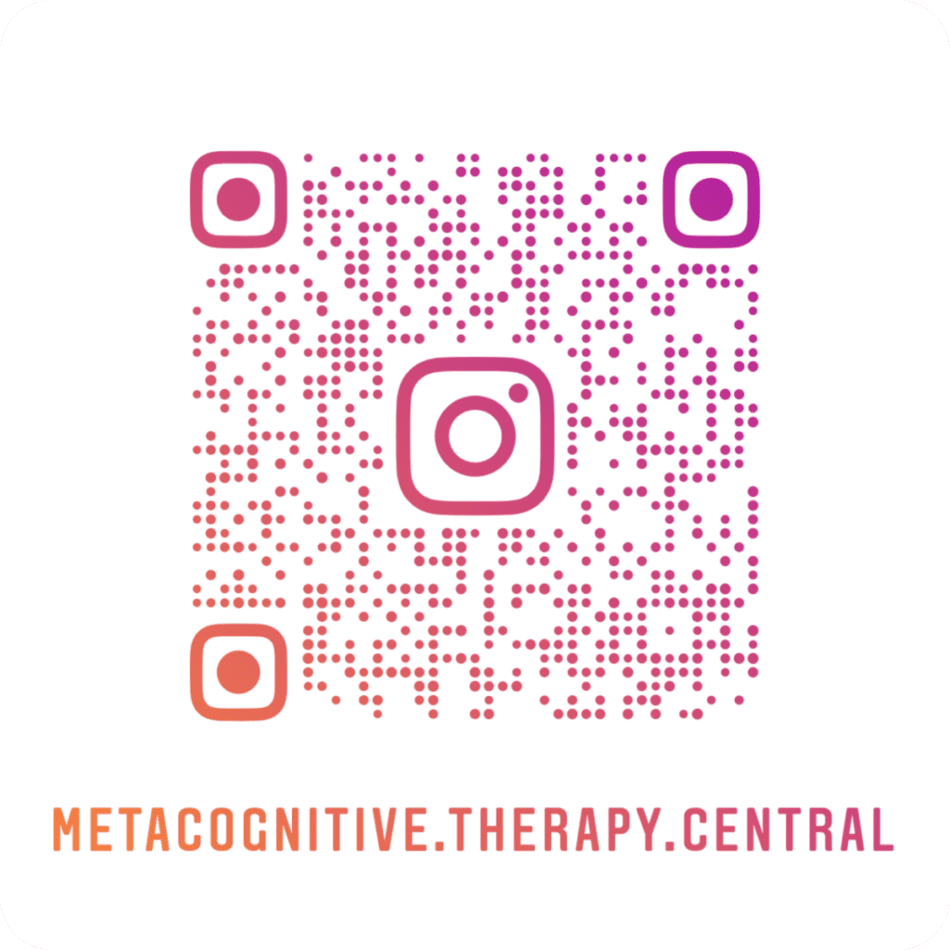
Imagine if you had full control over your attention. If you wanted to, you could focus away from the anxiety you are feeling in your body and into the present moment.
Or maybe you are struggling to stay focused on a task because you are disturbed by the noise around you. So you choose to focus even more and ignore the other sounds around you until you no longer think that you can hear them.
The attention training technique, ATT consists of listening to different sounds from different locations in space. It is part of MCT and helps you regain attentional control and disrupt extreme self-focus and unhelpful thinking patterns like worry and rumination.
It is possible to control your attention and move it around flexibly. In fact, you already have that ability, but you are not aware of it. So to be reminded of this ability, you can train your attention with ATT, developed by Professor Wells as a part of Metacognitive therapy (MCT).
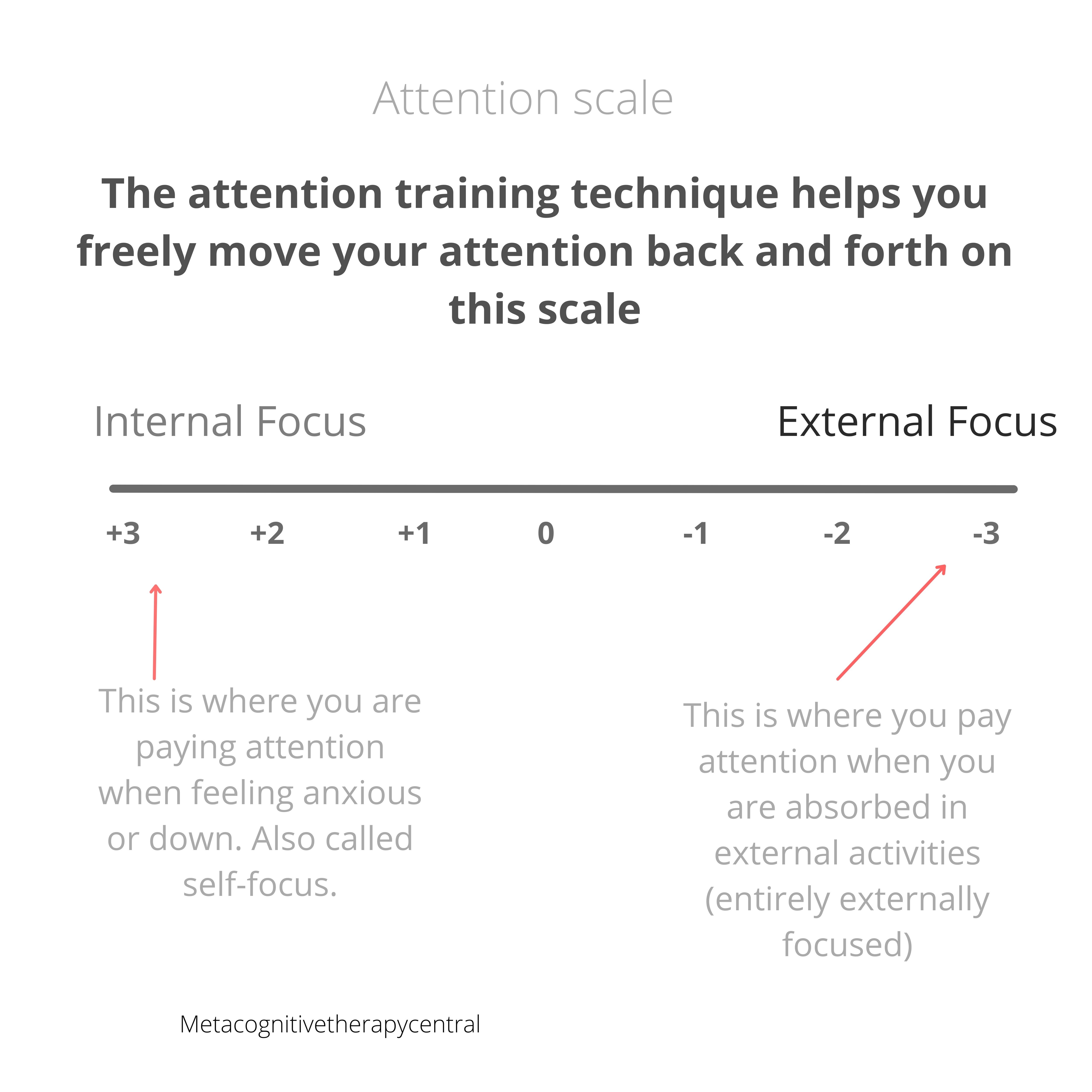
What is the attention training technique?
The attention training technique (ATT) requires you to listen to different sounds around you at different time intervals. These sounds may come from different spatial locations in your surroundings, such as TV, traffic, people talking, music, or construction work, as well as recorded sounds on audio.
Sometimes, you may not hear all the sounds, and often, during this exercise, you might get distracted by your thoughts. This makes ATT an attentionally demanding listening task, and the goal is to help you disconfirm false beliefs about your attention. Some of these beliefs may sound like:
I am not able to concentrate
I can’t focus away from my thoughts
I can’t help but notice how anxious I feel
I can’t control my attention
The attention training technique helps you believe that you control your attention, no matter how you feel or what’s around you. Knowing this helps you focus away from ‘inner noise’ and reduce some of the unhelpful ways you typically deal with negative thoughts and emotions.
“The selective attention section consists of instructions to focus on individual sounds in an array of competing sounds at different spatial locations. This is followed by rapid attention switching between both spatial locations and the individual sounds with gradually increasing speed. The exercise concludes with a section of divided attention, in which the listener is instructed to expand his or her attention to process multiple sounds and locations simultaneously“
Wells, 2009
| ATT is helpful | ATT is NOT helpful |
| To rediscover control over your attention | To make negative thoughts go away |
| To challenge false beliefs you have about attention | To feel less anxious |
| To challenge false beliefs you have about worry/rumination | To feel calm and relaxed |
| To help you bring worry/rumination under control | To help you fall asleep |
| To help you move attention around flexibly | To distract yourself from unpleasant thoughts/emotions |
| To make you aware of how you are dealing with negative thoughts | Meditation exercise |
With the guidance of a skilled therapist, ATT can show you how to see your thoughts as inner noise instead of accurate and important information. This makes it easier to step back from unhelpful and intrusive thoughts without needing to force them away or distract yourself.
Why is it helpful to strengthen beliefs about your attention?
Knowing that you can choose where to focus your attention helps you avoid and deal with mental health issues. Research shows that constantly focusing on and dwelling on our thoughts can lead to anxiety and depression. ATT helps strengthen the belief, that we can focus on other meaningful things instead of constantly dwelling on our negative thoughts.
ATT is part of Metacognitive therapy, a helpful treatment for mental disorders like anxiety and depression. This therapy suggests that certain habits with our thoughts, like worrying too much, can contribute to these problems.
What is worry and rumination?
Worrying and rumination are active ways we deal with thoughts that come up in the mind. When we ruminate and worry, we build on the initial thought with more thoughts or questions. For example:
The initial thought that pops up spontaneously: Did I turn off the stove?
Worrying: I don’t remember whether I did. What if I burn the house down! I can’t go back and check. Maybe I should call my husband and ask him to check. But what if it’s too late…
The initial thought that pops up spontaneously: I will never get a girlfriend
Ruminating: Of course I won’t. Who would ever date me? I am such a failure. I can tell from the way women look at me that I am odd and unattractive. What is the point anyway…
Worrying/ruminating is similar to jumping on a thought train and driving all the way to the dodgy end station, which leaves you scared, sad, and confused.
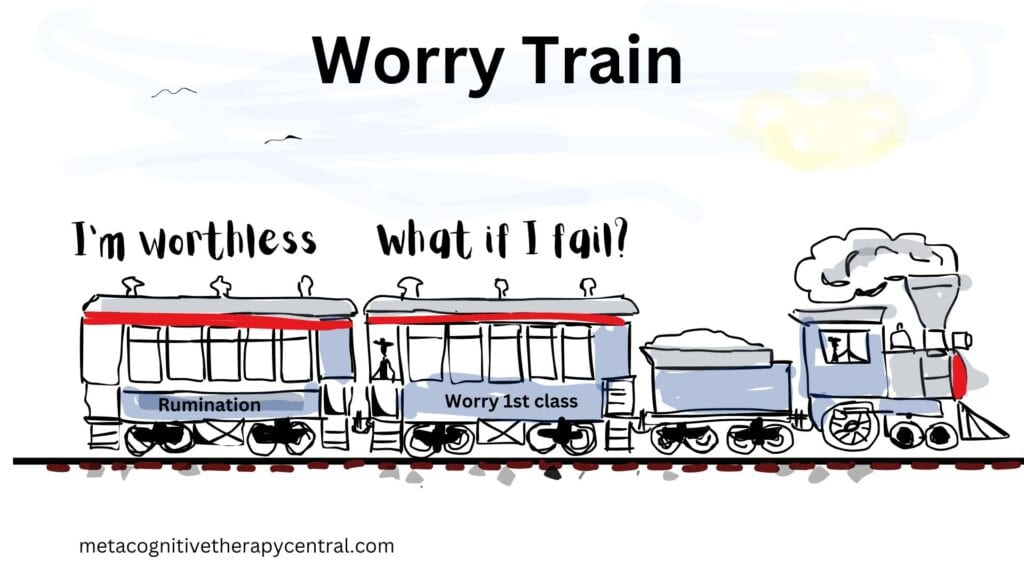
Worrying too much about random thoughts that pop up in our minds often makes us feel worse. According to MCT, doing this for a long time can lead to anxiety, depression, and even OCD.
When we keep ruminating and worrying, we focus most of our attention on this process and notice all the negative and intrusive thoughts and feelings. This makes us dwell on the bad things our thoughts tell us and how awful we feel, missing out on the good things happening around us.
For example, someone anxious in social situations may focus on how they sound or come across, missing the positive reactions from others. ATT can help by making them aware they can shift their focus away from anxiety and notice the positive things around them. If they focus their attention externally and away from their thoughts, they will probably notice how likable, funny, or interesting other people find them, or that no-one is judging them.

What is the point of the attention training technique?
Practicing ATT comes with various benefits, especially when someone is undergoing Metacognitive therapy. The specific exercises in therapy enhance the effectiveness of ATT.
When my clients practice ATT, they typically experience the following:
- A better sense of control over what they focus on (I decide what I want to focus on, not my thoughts)
- Less bothered by distractions (both from the outside and from thoughts/feelings)
- More aware of how much they are worrying/ruminating during the day
- Better able to stop worry/rumination (not the same thing as stopping thoughts!)
- An improved ability to view their negative thoughts for what they are: just thoughts and not facts
- More productivity (getting more things done) probably due to less time spent overthinking
Lack of attention control = vulnerability to mental illness
According to Wells, not believing that we can control our attention makes us vulnerable to developing mental disorders (7). For example, if someone spends many hours focusing on how anxious they feel or checking for signs of panic, they are extremely internally focused. This type of inflexible focus makes it easier to notice more symptoms (which are natural fluctuations in the body), triggering more worry and more intrusive thoughts.
Basically, an inflexible internal focus can perpetuate anxiety, stress, and sadness, especially if we at the same time worry about the feelings that we are noticing.
Most of my clients notice a similar pattern caused by an inflexible internal focus as shown below:
Internal focus –> noticing anxiety in the body –> getting a trigger thought, “something is wrong” –> worrying about the thought –> noticing more anxiety –> worrying more –> more anxiety…
To avoid developing an anxiety or depressive disorder, it is important to regain control over our attention. But here is a more accurate way of describing attentional control:
We always can control our attention. We have just forgotten about this ability. The attention training technique helps us rediscover this control.
When my clients start therapy, most of them don’t believe that they can control their attention. They tell me things like, “I can only focus my attention away from my thoughts when I am engaged in something interesting or important” or “When I feel very anxious, there is no way I can focus on other things“
What my clients are describing to me is their beliefs about their minds and how it works. In Metacognitive therapy, these are called Metacognitive beliefs.
Examples of Metacognitive beliefs are:
I can’t control my attention
I can’t control worry/rumination
Metacognitive beliefs play an important role in activating worry, rumination, and direct attention to negative thoughts or feelings.
We all have metacognitive beliefs and believe in them to varying degrees (0 =I don’t believe that at all, and 100 = I am completely convinced).
If you don’t believe you can control your attention, you won’t try to focus away from negative thoughts or feelings. Instead, you get locked into extreme self-focus and give your negative thoughts, feelings, and symptoms your full attention (typically by worrying and ruminating about them for hours). This makes you feel worse emotionally.
According to studies about Metacognitive therapy, metacognitive beliefs about the uncontrollability of attention (e.g., “I can’t control my attention” and “I can’t control rumination/worry“) accurately predict why some people are more vulnerable to getting anxious and depressed compared to others (4).
People with mental illness usually don’t believe that they can control their attention and end up worrying for hours. If the worry isn’t stopped, it can lead to anxiety.

How is the attention training technique used in therapy?
In therapy, ATT is practiced with sounds from inside and outside the therapy room. My clients are instructed to keep their eyes open and focus their attention in different ways (for long and short durations on one sound at a time, and then on all the sounds at the same time) meanwhile leaving thoughts and feelings alone.
Whenever they are distracted by thoughts/feelings or other sounds, they are instructed to refocus their attention on that particular sound they were listening to before they got distracted.
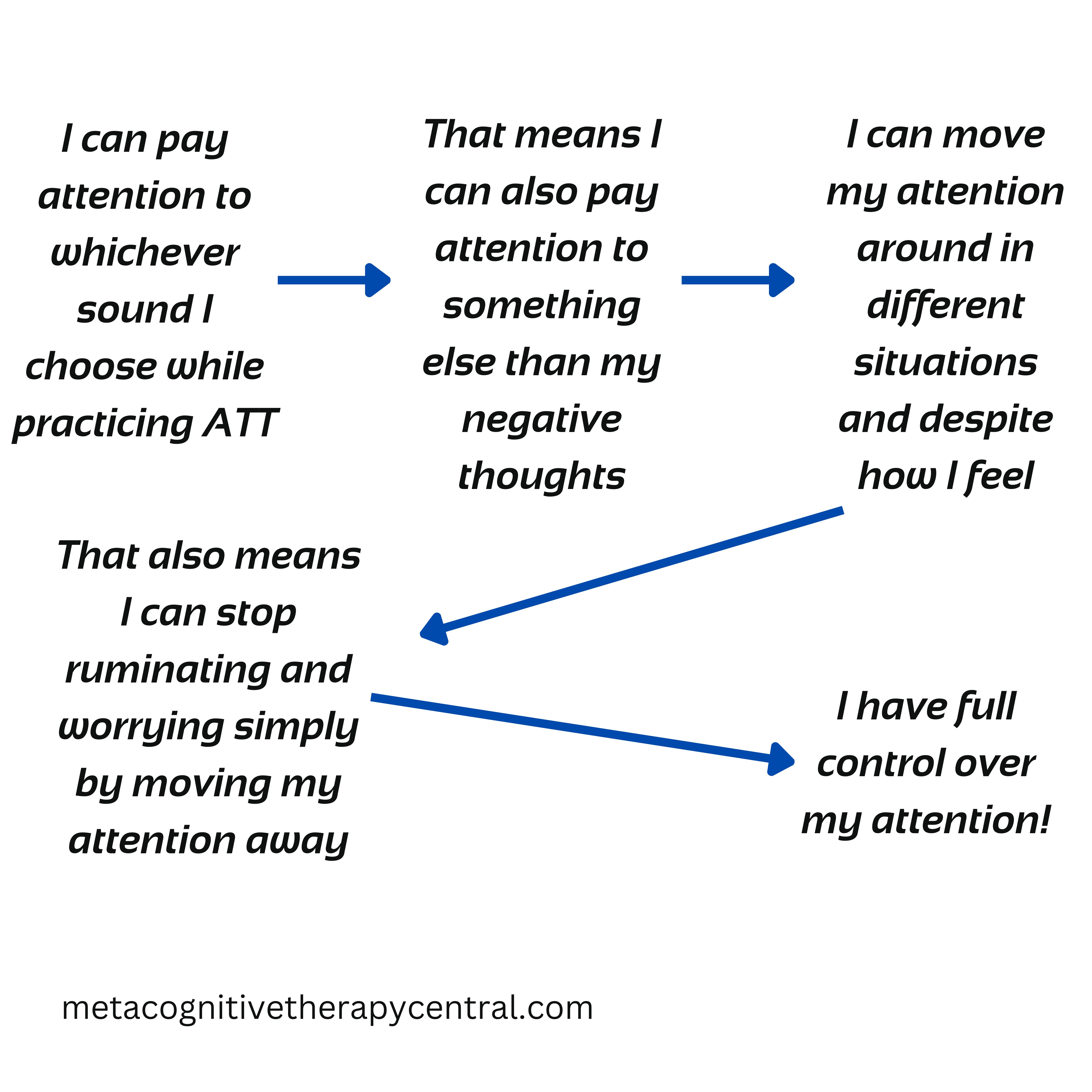
What are the different types of attention training?
There are three ways you can train your attention in Metacognitive therapy, all developed by Professor Adrian Wells:
- The attention training technique (ATT)
- Spacial attention control exercise (SpACE)
- Situational attentional refocusing (SAR)
Although a recorded version of ATT exists (created by Professor Adrian Wells), using sounds from the surroundings is, according to Wells, equally effective in training attention. (See instructions below). In fact, a recent development of the attention training technique is called SpACE (spacial attention control exercise), which requires no recording and even no sounds(9). But the idea is the same: to move your attention around to different locations in space and try to listen for any sounds.
However, with some clients, there is no need for the attention training technique. Usually, they only need a few exercises in our sessions to help them rediscover control over their attention, inspired by SAR (situational attentional refocusing) For example, I usually challenge my clients to start doing chores/studying/working during our online sessions. And while they do that, they are instructed to moving their attention back to that task every time they get distracted by negative thoughts. This exercise usually helps them strengthen the belief that they indeed can control what they pay attention to. EVEN when they’re feeling anxious and upset.
ATT teaches you to distance yourself from thoughts and feelings and move your attention toward other meaningful things. Most importantly, ATT strengthens the belief that you are in full control of your attention.
Free MCT E-Book
How to leave thoughts alone and use worry postponement instead of worrying and ruminating about your thoughts. Download the free e-book to help you put your MCT strategies into practice here.
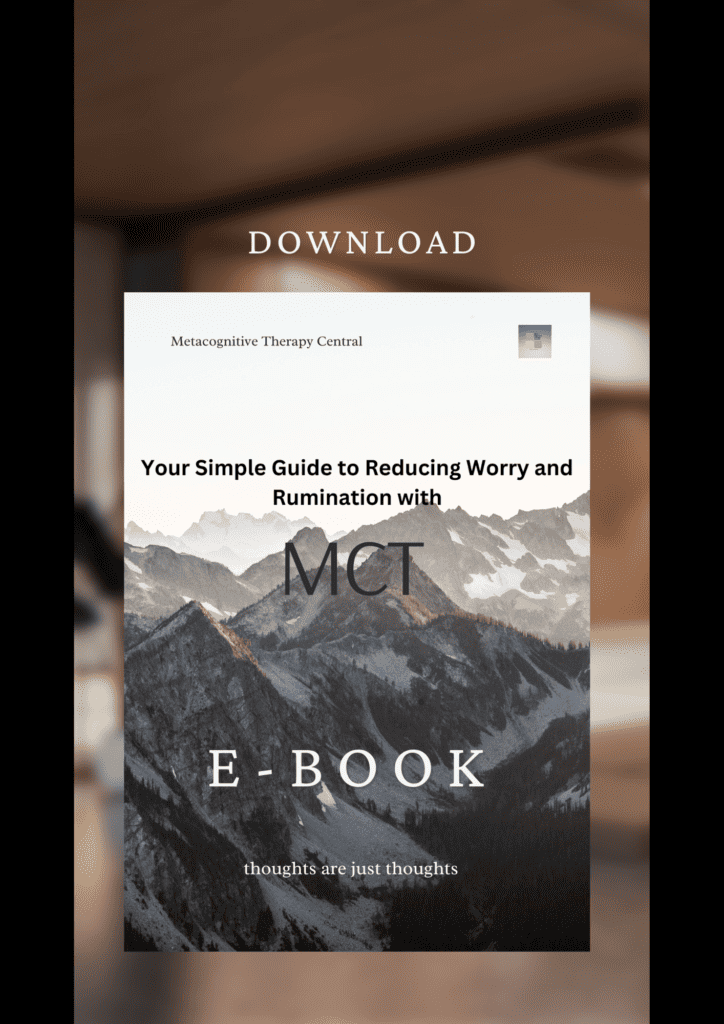
The attention training technique shouldn’t be used alone
There are a lot of different versions of the ATT available on the web. Unfortunately, most people don’t yet understand the reason for using them and instead misuse them as a relaxation technique or thought suppression tool because they experience feeling calm from listening to them.
ATT should never be used to avoid or control negative thoughts, feelings, or symptoms. ATT is not a tool to help calm down or stop having negative thoughts.
Not understanding the reason for when and why you should use ATT will prevent you from overcoming mental illness and dealing with overthinking in the long term. So although you may notice short-term benefits like a clearer mind and calmness, your beliefs about your attention are still unchanged. You may still not believe that you can move your attention around flexibly when you are feeling extreme panic, social anxiety, or racing thoughts.
It is important to practice ATT in the context of Metacognitive therapy. Your therapist will use ATT to help you break limiting beliefs about your attention. This will help you overcome anxiety and depression for good.
Although studies show that ATT practice on its own can be effective (6)(7), further studies are needed to fully evaluate the effects of using ATT alone. At present, the best effect of ATT is seen when it is used as a part of Metacognitive therapy (1).

Metacognitive therapy’s effect on treating emotional disorders is already backed up by large clinical trials (2)(8). Metacognitive therapy is already established as an effective treatment for depression and anxiety disorders. You can read more about the scientific proof behind Metacognitive therapy here.
How can I practice attention training?
Attention Training Technique (ATT)
You can practice becoming more aware of your attention and strengthen your control over it by following the guidelines below. In order to experience the benefits of the attention training technique, it is recommended to practice daily for four weeks. Ideally, you should practice twice a day. Each session should last 12 minutes (1).
The training is divided into three phases:
- 5 minutes of selective attention
- 5 minutes of rapid attention switching
- 2 minutes of divided attention
Set aside 12 minutes at least once per day. Choose six to nine different sounds around you that you can hear and follow this routine:
- Phase one: listen to each sound for one minute at a time
- Phase two: listen to each sound for 10-20 seconds
- Phase three: listen to all the sounds you can hear at the same time for two minutes
During the training, you will experience thoughts, feelings, and urges come up. You shouldn’t try to stop them or control them in any way. Just let them come and go of their own accord.
You have practiced ATT correctly if you notice your attention moving two points toward an external focus on the scale below. So make sure you measure your attention the scale before and after ATT (However, do not overthink or monitor for this DURING the listening face. Just focus on listening and do your best).
ATT practice check-list
| You practiced ATT right | You practiced ATT wrong |
| You brought your attention back to the sounds whenever you got distracted | You tried to make your thoughts/emotions go away while listening |
| You did not try to make your thoughts/emotions disappear while listening | You kept checking whether you were making progress |
| Your attention has moved two points toward external focus | When you got distracted you didn’t try to bring your attention back to the sounds |
How to apply attention training to your daily life
On a normal day, your attention typically wanders across the whole scale, from being fully consumed in your thoughts to being fully focused on something outside of yourself. Your attention is flexible, and you have complete control over it.

For example, you can control whether you focus and dwell on negative thoughts and feelings or on events that are happening right now in the present moment.
Allow yourself to be consumed by things you can see and hear in your surroundings regardless of your need of analyzing your problems. So instead of focusing on your thoughts/emotions, refocus your attention back to the activity you were doing before you got distracted (whether it’s cleaning, working, writing, talking, cooking, or just staring out the window).
If you really need to dwell on your thoughts, decide to only do this in your scheduled worry/time.
As a bonus, you may find yourself coming up with better solutions to your problems when you move your attention away from your thoughts from time to time. And you will feel much better emotionally.
Use different situations in your everyday life as opportunities to practice attention control. Focus away from analyzing and worrying about your negative thoughts and instead focus back on work, conversations, and other daily activities WHILE YOU STILL HAVE THESE THOUGHTS/FEELINGS BUZZING IN THE BACK OF YOUR MIND.
Who invented ATT?
ATT was originally developed by Professor Adrian Wells from Manchester University. The purpose of ATT was to impact dysfunctional mental strategies ( like excessive self-focus, rumination, and worry) and change people’s metacognitive beliefs, which are dysfunctional beliefs that people hold about thinking. Examples of metacognitive beliefs that ATT will help change are:
I can’t control my attention
I can’t stop ruminating
My worrying is controlling me
People with mental illnesses like anxiety, panic disorder, and depression tend to have extreme self-focus to monitor their mood and symptoms.
For example, people with depression don’t believe they can stop ruminating about their depressive thoughts. Therefore, they don’t try to break away from rumination and continue to feel depressed. (According to Metacognitive therapy, excessive rumination is the reason that people stay depressed. You can read about how Metacognitive therapy treats depression in this post).
People with anxiety also don’t believe they can stop worrying and monitoring their symptoms. Instead, they try to control their worrying in other ways, like suppressing their thoughts and avoiding anxiety-triggering situations. These strategies don’t work in the long term and usually trigger more anxiety.
It therefore seems that excessive internal focus blocks healthy emotional processing and maintains symptoms of anxiety and depression.
So to recover from anxiety and depression, it is very important to learn that rumination and worrying can be stopped. This can be achieved through ATT in combination with Metacognitive therapy.
ATT is helpful in breaking extreme self-focus so that the mind can process negative emotions on its own. This is called self-regulation.
Summary
ATT is a listening task that requires you to listen for different sounds around you for about 10-12 minutes.
ATT is developed as a part of Metacognitive therapy to help change false beliefs about attentional control (I can’t control what I pay attention to).
Once you rediscover that you are in full control of your attention, you can easily focus away from intrusive thoughts and instead move your attention to other things (that are more important in your life) despite how you feel.
Remember that you shouldn’t use the ATT as a coping strategy in response to negative thoughts or feelings.
The goal with ATT is to show you that controlling your attention is independent of internal (thoughts) or external (sounds) events.
You don’t need an audio recording of the ATT to practice attention training. Use whatever sounds that are available around you.
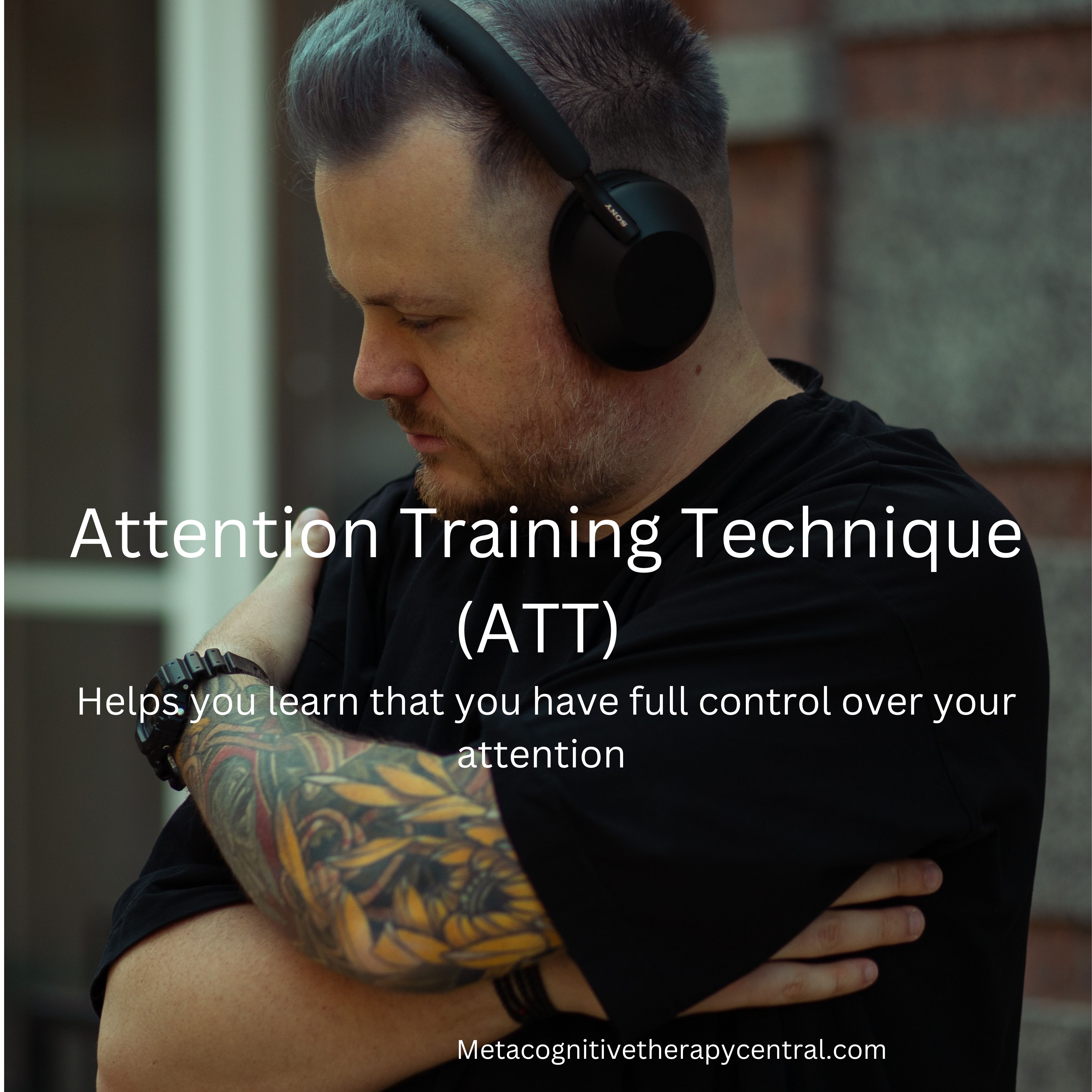

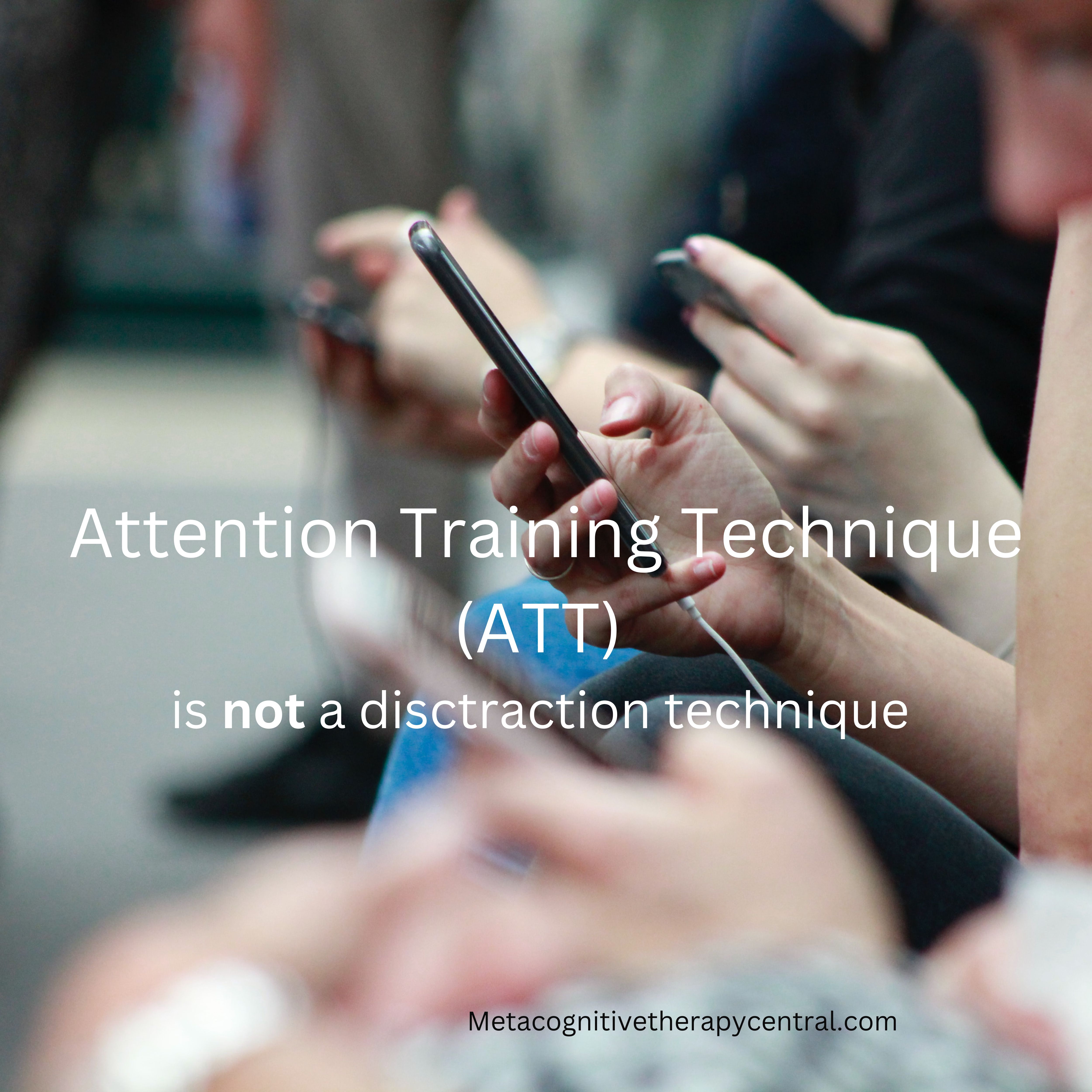

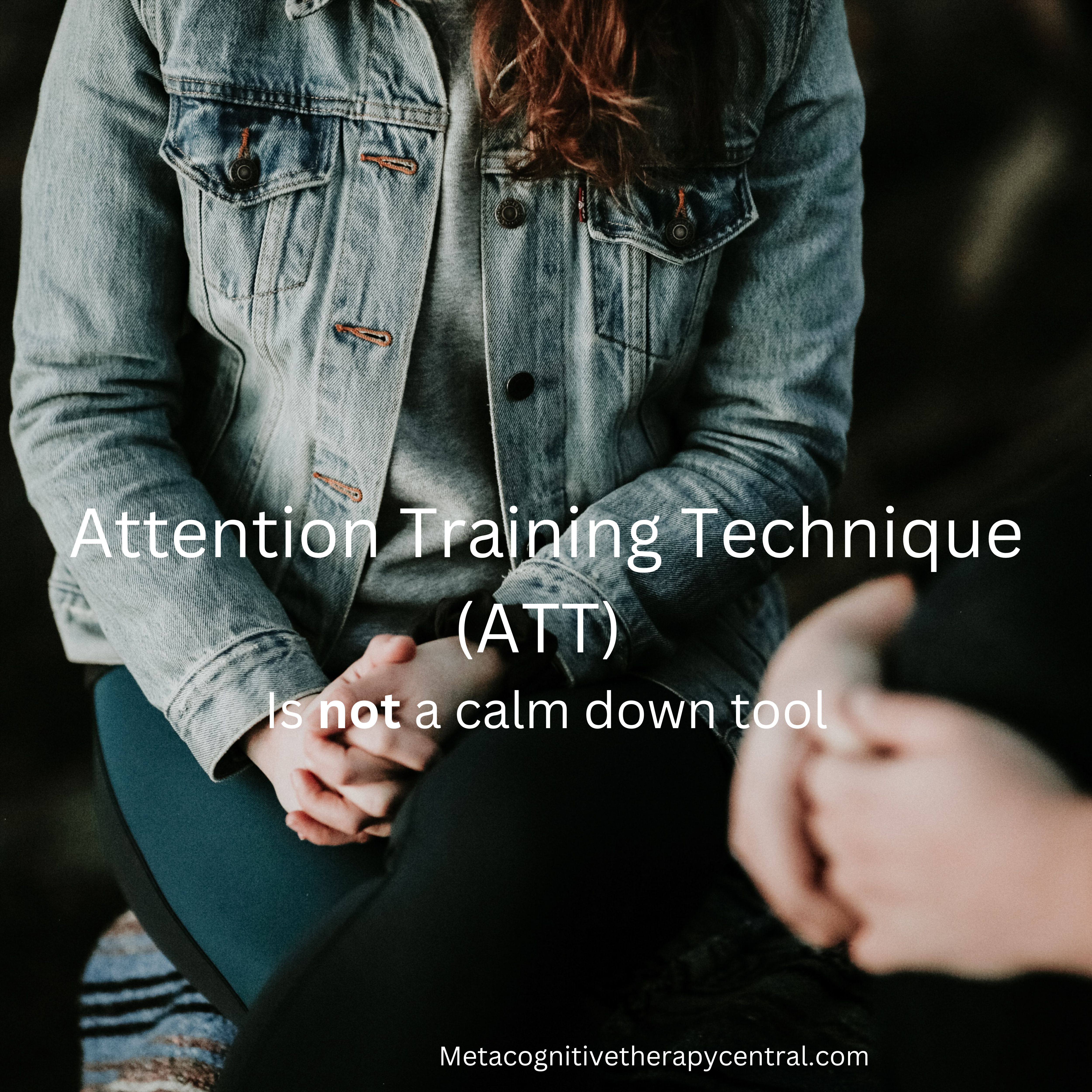
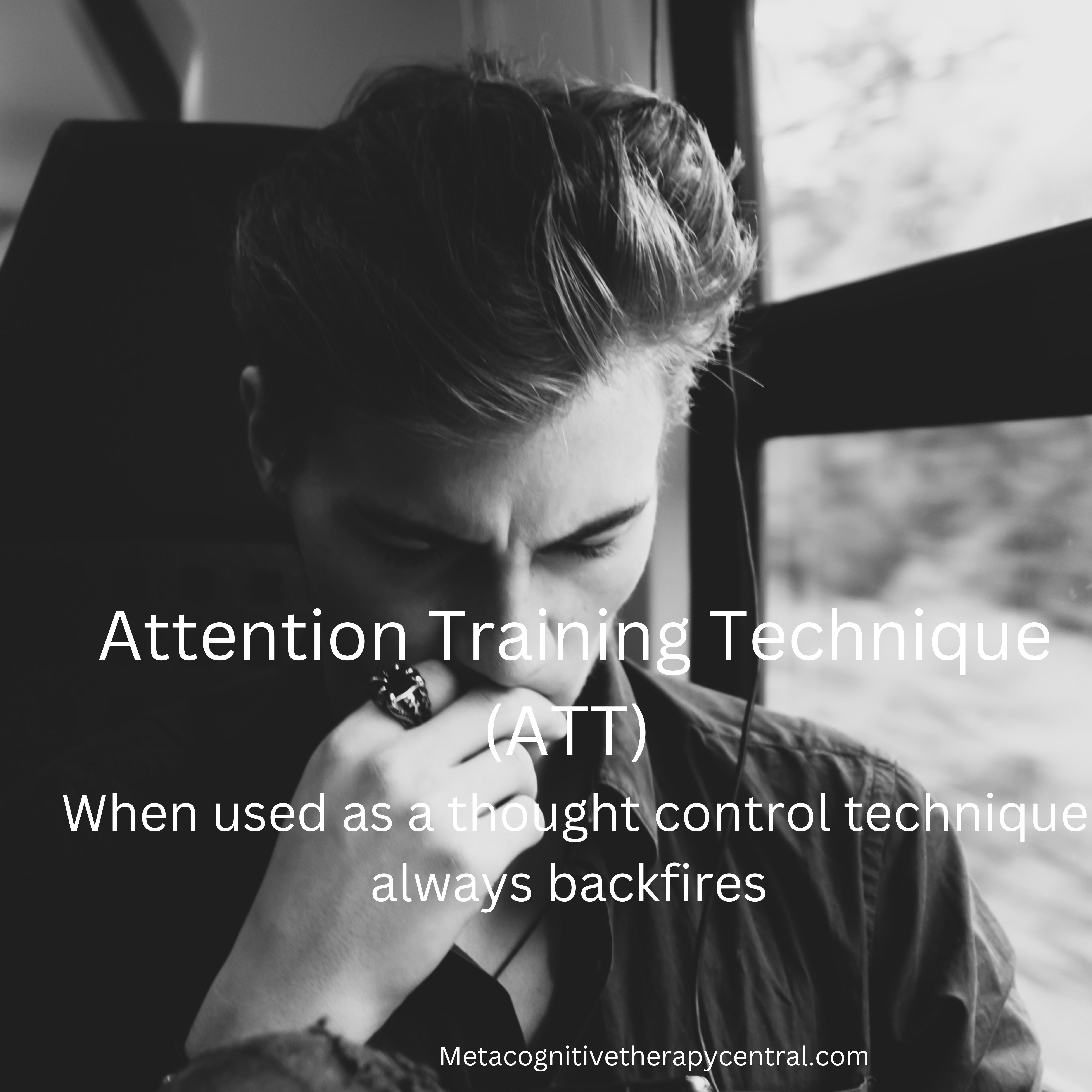

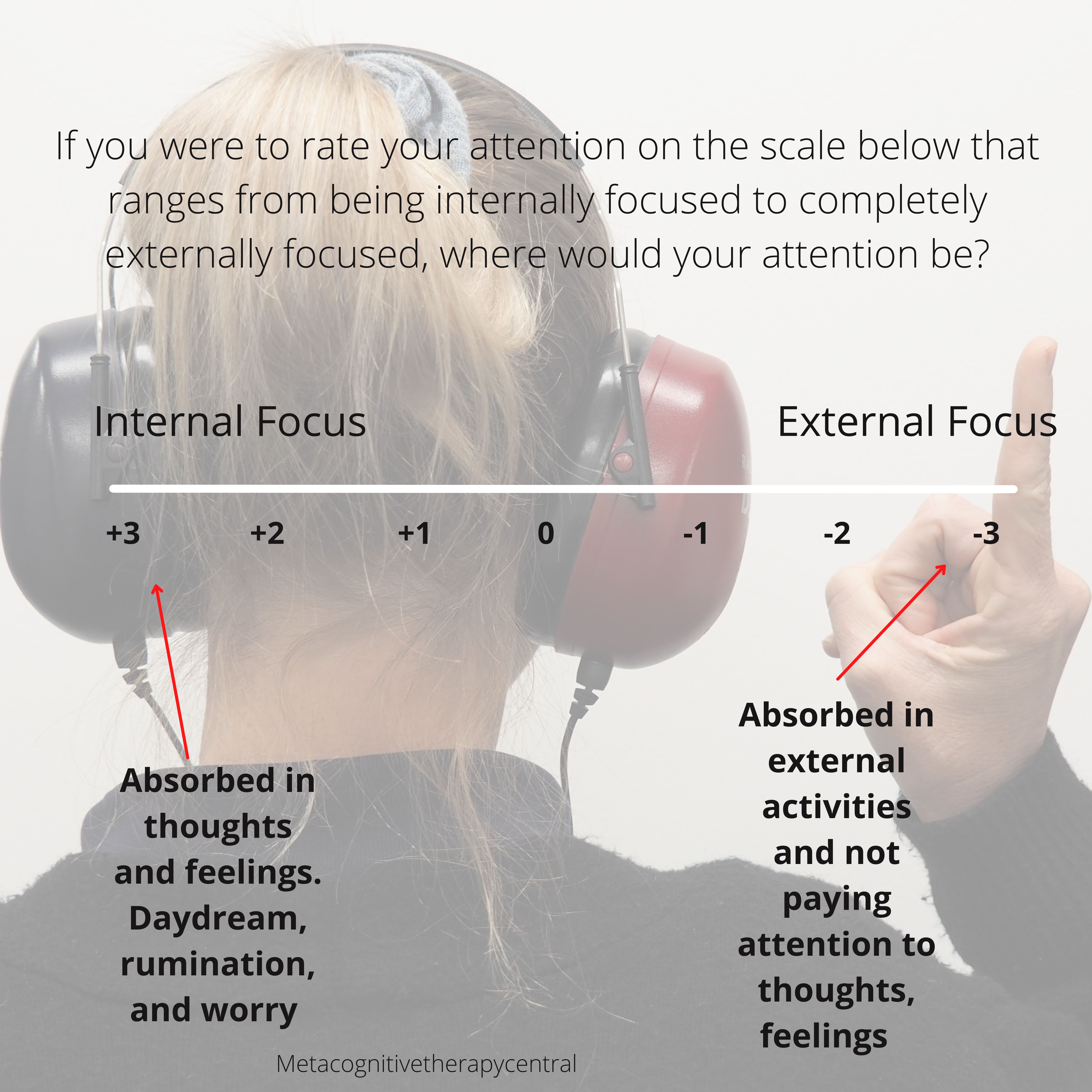
References
- Attention scale from Wells, A., (2009). Metacognitive therapy for anxiety and depression. Guilford press.
- Normann & Morina, The Efficacy of Metacognitive Therapy: A Systematic Review and Meta-Analysis, Front. Psychol., 14 November 2018 | https://doi.org/10.3389/fpsyg.2018.02211
- Wells, A., & Matthews, G. (1994). Attention and emotion: A clinical perspective. Lawrence Erlbaum Associates, Inc.
- Hirsch CR, Mathews A. A cognitive model of pathological worry. Behav Res Ther. 2012 Oct;50(10):636-46. doi: 10.1016/j.brat.2012.06.007. Epub 2012 Jul 7. PMID: 22863541; PMCID: PMC3444754.
- Wells, A., & Papageorgiou, C. (1998). Social phobia: Effects of external attention on anxiety, negative beliefs, and perspective taking. Behavior Therapy, 29(3), 357–370. https://doi.org/10.1016/S0005-7894(98)80037-3
- Knowles MM and Wells A (2018) Single Dose of the Attention Training Technique Increases Resting Alpha and Beta-Oscillations in Frontoparietal Brain Networks: A Randomized Controlled Comparison. Front. Psychol. 9:1768 doi: 10.3389/fpsyg.2018.01768.
- Barth V, Heitland I, Kruger THC, Kahl KG, Sinke C and Winter L (2019) Shifting Instead of Drifting – Improving Attentional Performance by Mean of the Attention Training Technique. Front. Psychol. 10:23. doi: 10.3389/fpsyg.2019.00023
- Callesen, P., Reeves, D., Heal, C. et al. Metacognitive Therapy versus Cognitive Behaviour Therapy in Adults with Major Depression: A Parallel Single-Blind Randomised Trial. Sci Rep 10, 7878 (2020). https://doi.org/10.1038/s41598-020-64577-1
- Wells A, Reeves D, Capobianco L, Heal C, Davies L, Heagerty A, Doherty P, Fisher P. Improving the Effectiveness of Psychological Interventions for Depression and Anxiety in Cardiac Rehabilitation: PATHWAY-A Single-Blind, Parallel, Randomized, Controlled Trial of Group Metacognitive Therapy. Circulation. 2021 Jul 6;144(1):23-33. doi: 10.1161/CIRCULATIONAHA.120.052428. Epub 2021 Jun 21. PMID: 34148379; PMCID: PMC8247550.
